
Pork Menu: 1 2 3 4 5 <<First
Pork on Ships: Pork Bred Wild
During their explorations of the new world, European travelers recognized that their ships would need restocking after the long voyage from Europe, so they began to bring livestock to foreign shores and leave them. That way they hogs could proliferate and provide much-needed provisions to future voyagers. Pigs proved to be a hardy transplant.
Alexander Hamilton explained that in Madagascar "when the Portugueze first sailed along the Coasts of this Island, they left a Brood of Hogs, that has mightily increased."1 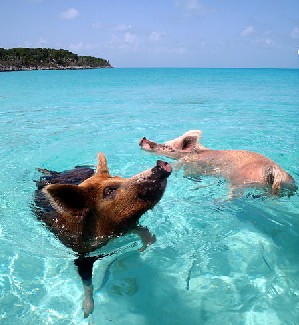
Photographer: C. Dorobeck
Wild Swimming Pigs Which Inhabit
Big Major Cay. They Were Originally
Introduced to the Bahamas by Europeans In Luconia (in the Philippines) William Dampier commented that there was "plenty of other [non-cow] Cattle, as I have been told, as Bullocks, Horses, Sheep, Goats, Hogs, &c. brought hither by the Spaniards."2
Eventual pirate John Auger, then captain of the May was part of a convoy of ships which stopped at Green Turtle Cay, in the Bahamas. The ship's crew "expected to meet some wild hogs, for some time before, one Joseph Bay and one Sims, put two sows and a boar on said island; for they living at that time at [New] Providence, and being continually visited by pirates, were always plundered of their fresh provisions, wherefore they thought of settling a breed upon Green Key [Green Turtle Cay], that they might have recourse to in time of necessity."3
How well Bay and Sims plan worked is debatable. The group hunting "killed but one hog, which, however, was of a monstrous size. The hunters returned on board their ships again before seven, having first divided the hog, and sent part on board each vessel for supper that night."4
1 Alexander Hamilton, British sea-captain Alexander Hamilton's A new account of the East Indies, 17th-18th century, p. 27; 2 William Dampier, Memoirs of a Buccaneer, Dampier’s New Voyage Round the World -1697-, p. 263; 3,4 Captain Charles Johnson, The History of the Pirates, p. 231
Pork on Ships: Hunting Naturally Wild Pork
Many 
Hunting Wild Pigs, From On the Spanish
Main,
by John Masefield, p. 114 (1906) of the period accounts mention places where wild pork could be found and hunted. Various islands and places around the Caribbean were ruled by different countries; countries often at war with one another. Because of this, a civilized port would not be safe for sailors from opposing country. Knowing uninhabited spots where sea travelers might find wild fresh provisions in enemy territory could be invaluable. Sailors traveling around the globe to unfamiliar locations would also benefit from information on wild food supplies.
Not surprisingly, a number of pirate accounts also talk of hunting wild pigs and hogs. Their situation as outlaws often required them to obtain food outside of the usual supply chain. While some ports were friendly to them, many weren't; pirates were essentially at war with everyone. So they often found themselves in need of a nice quiet place, preferably one well stocked with wild game.
Peccaries
Let's begin with descriptions of the quarry our sea-going hunters chased. Captain Nathaniel Uring provides an amusing and thorough description of a type of wild boar indigenous to the Caribbean, Central and South America, included here in full.
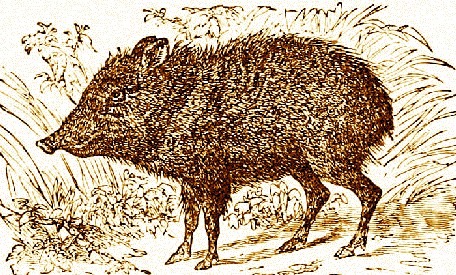
A Drawing of a Peccary from Popular Science Monthly (1872-3)
The Warree [Moskito Indian for peccary] is shaped like a Hog with this Difference, they are of a less Size, their Ears, Legs and Tail is shorter in Proportion than those of a Hog, and have what they call a Navel on its Back, which is placed about two thirds towards the Tail, and are two Lumps of Flesh about the Bigness and Shape of their Kidnies, which lies just within the Skin on each side of the Back Bone, between which issues out a Matter which casts forth a strong Scent, not much unlike that of a Fox; They keep in Droves; their Flesh is very sweet and good, I think much better than European Pork. When they find themselves hard chased, they will Turn upon Dogs or men, and often wound the Dogs with their Tusks; and sometimes the Men are in great danger of being Hurt by 'em: They are easily discover'd by the Scent. 'Tis an ordinary thing when they are to Windward of you, to smell a Drove of them more than a Mile.1
Sailor Bartholomew Sharp explains that "our Supper-Entertainment was a very good sort of Wild Beast called a Warre, which is much like unto our English Hog, and altogether as good. We found great store of them in this part of the World 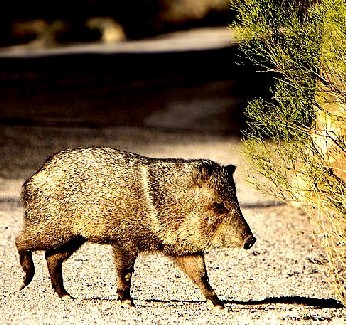
Photographer: Alan Vernon
A Wild Peccary Going About His Business [in South America]: I observ’d that the Navels of these kinds of Animals grew upon their Backs."2 William Dampier also reported on these curious creatures while visiting the Isthmus of Darien (modern Panama), giving a variation of their more widely-used name, 'Pecary' which he described as "a sort of wild Hog which we bought of the Indians"3.
The period reporters correctly identify peccaries as being something other than pigs or hogs. They are also correct in pointing out that these creatures are similar to pigs; peccaries are in the same scientific suborder. They are native to the much of South America, most of Central America and parts of southern North America.
Not everyone is quite as sharp-eyed as our period writers; peccaries are often confused with 'razorback' or wild hogs, which were brought to the Americas beginning in the 16th century by European travelers to establish convenient food sources as was mentioned on the previous page. The 'navel' on the back of the peccary reported by Uring and Sharp is actually a scent gland used to mark territory and other members of their herd.4
1 Nathaniel Uring, A history of the voyages and travels of Capt. Nathaniel Uring, p. 144-5; 2 Bartholomew Sharp, "Captain Sharp's Journal of His Expedition," from William Hacke's A collection of original voyages, p. 4; 3 William Dampier, Memoirs of a Buccaneer, Dampier’s New Voyage Round the World -1697-, p. 18; 4 Peccary, wikipedia.com, gathered 4/16/14; a
Hunting Wild Pork Locations
"Like wild cattle, the earliest boucaniers had also hunted wild pigs on French Hispaniola, and pork was to remain a favorite meat among Antilliean residents and visitors alike, despite being somewhat less abundant than turtle or beef." (David F. Marley, Daily Life of Pirates, p. 47)
Being popular food, both sailor's and pirate's accounts contain multiple examples of them hunting for wild pigs and their cousins from this time. As befits the commercial interests of the era, most of these accounts come from three areas - the North Atlantic/Caribbean, the Indian Ocean and the China Sea.
Hunting Wild Pork Locations - North Atlantic/Caribbean
The land around the North Atlantic area abounded in sources of pork during the golden age of piracy, with peccaries and wild hogs to hunt. While on the Caribbean island of St. Lucia, our trusty French epicure, Père Labat, explained "I found a sufficient store there of wild pig boucanne and pigeon to realize that one need not die of hunger, so I sent for my hammock, and some biscuits, wine and brandy, and resolved to spend the night in the woods with our people."1
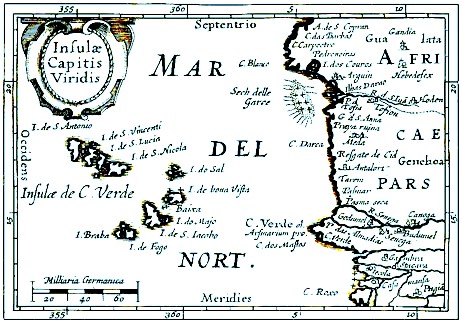
Map of the Cape de Verde Islands, National Library of France (1598) On the other side of the Atlantic, off the coast of central Africa, captain William Funnell recorded that the island of St. Jago "is one of the Southermost and most fruitful of the Cape de Verde Islands; it abounding in Hogs, Fowls, Guinea-Hens, [and] Monkies"2.
After a devastating engagement with the merchant ship Amy in 1722, pirate captain George Lowther "made Shift to get into an Inlet somewhere in North-Carolina, where he staid a long while before he was able to put to Sea again. He and his Crew laid up all the Winter, and shifted as well as they could among the Woods, divided themselves into small Parties, and hunted generally in the Day Times, killing of black Cattle, Hogs, &c, for their Subsistance"3. Perhaps the fresh pork was part of the soothing balm that allowed Lowther's crew to plunder the Newfoundland Banks the next year.
1 Pere Jean-Baptiste Labat, The Memoirs of Pére Labat 1693-1705, p. 140-1; 2 William Funnell, A Voyage Round the World, p. 5; 3 Captain Charles Johnson, A general history of the pirates, 3rd Edition, p. 362; 0
Hunting Wild Pork Locations - China Sea
Privateer 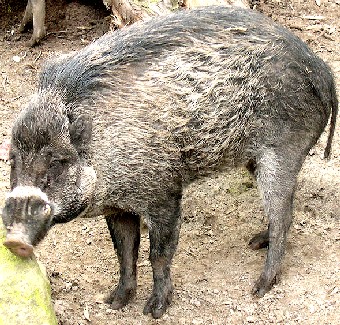
Photographer: Wiki Commons User Magalhães
The Visayan warty pig (Sus cebifrons) William Dampier found hogs on his voyages in China during his extended circumnavigation of the globe. As with many things Dampier found novel, he provided some some detail into what he observed.
In 1686, while in Mindanao, an Island off the Philippines, he explained that the wild hogs there were "ugly Creatures; they have all great Knobs growing over their Eyes, and there are multitudes of them in the Woods. They are commonly very poor, yet sweet."1 It is likely he was talking about warty pigs, of which there are a variety in the Philippines. The types found include the Visayan warty pig (Sus cebifrons), the Philippine warty pig (Sus philippensis) and the Mindoro warty pig (Sus oliveri).2
While visiting St. Johns (or Shangchuan) Island, located off of Canton, China, Dampier explained how, "with seven or eight Englishmen more, and having occasion to stay some time, we killed a Shote, or young Porker, and toasted it for our Dinners. While we were busy dressing of our Pork, one of the Natives came and sat down by us; and when the Dinner was ready, we cut a good Piece and gave it him, which he willingly received."3
1 William Dampier, Memoirs of a Buccaneer, Dampier’s New Voyage Round the World -1697-, p. 220; 2 Wild pigs of the Philippines, wikipedia, gathered 4/18/14; 3 Dampier, p. 278
Hunting Wild Pork Locations - Indian Ocean
The greatest number of sailor's pig hunting accounts come from places around the Indian Ocean. This is not all that surprising given that the original distribution of wild boars included North Africa and much of Eurasia.1
In 1685, Edward Barlow explained that in Karwar, 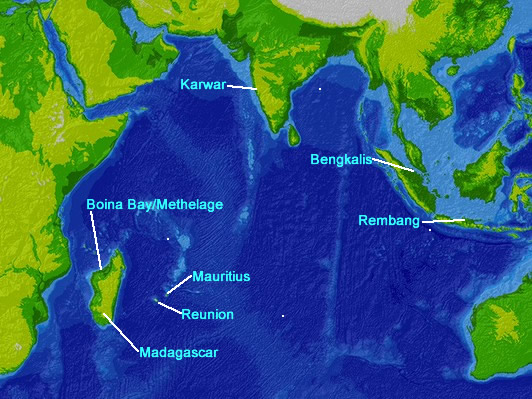
Northern Indian Ocean Wild Pig Locations Mentioned Here India "flesh meat was not to be had, unless wild deer and hogs, some fowl and much fish". In this entry, Barlow also noted that the Indians held "a cow or bull in such admiration that they will not part with one to kill if you would give them five hundred pound"2.
Sailor Alexander Hamilton found wild hogs in two cities in Indonesia during his travels. The first were in Bengkalis. Hamilton relates that "in the Months of December and January, their Flesh is very sweet and fat."3 He also explains that in Rembang, there were "wild Hog and Deer [which] we killed daily with our Fowling-pieces, as we did also Peacocks and wild Poultry."4
A 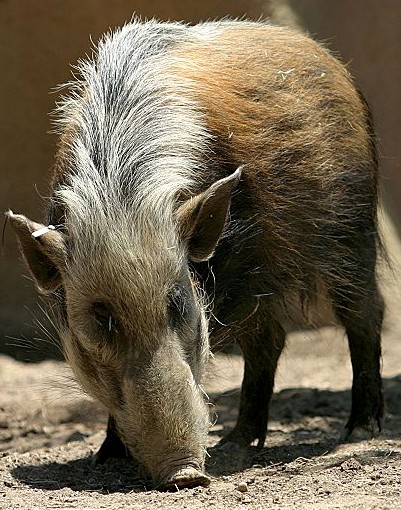
Photographer: Wiki Commons User C. Burnett
A Southern Bush Pig ( (Potamochoerus larvatus koirpotamu) lot of pork hunting occurred in and around Madagascar, thanks to the pirates who took up lodging there. The wild hog is not native to Madagascar, so it was most likely introduced to the island. "The pigs found in Madagascar are thought to be bushpigs, although there is some debate amongst authorities as to whether the Madagascar pigs are truly bushpigs or not."5 Still, the specie found on Madagascar - Potamochoerus larvatus hova - is presently thought to be a subtype of the auburn-tinted bush pigs found in Central Africa. The hova subspecies is more greyish than auburn.
Captain Charles Johnson reported that when Edward England sent men on shore of Madagascar, they took "Tents, Powder, and Shot, to kill Hogs, Venison, and such other fresh Provision as the Island afforded"6. When pirate captain Thomas Howard stayed on the island, Johnson said, "They had here plenty of fish and wild hogs which they found in the woods."7 Johnson explains that pirate Thomas White's crew "went into a harbour [Methelage – Boina Bay, on the northwest coast of Madagascar] and stayed there a month, maintaining themselves with fish and wild hogs, of which there was a great plenty."8
About 5-600 miles east of central 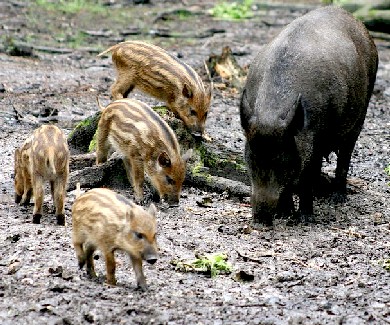
Photographer: Dave Pape - Wild Boar (Sus Scrofa) and Young Madagascar are two small islands which were popular stopping points for refreshing supplies - Reunion and Mauritius. In 1689 Edward Barlow said of Mauritius, "This island aboundeth with store of good fresh provisions, only it wants bread corn. Here is store of good wild deer and wild goats and hogs, and sea and land turtles or tortoises, and plenty of fresh good fish."9 (Note that Barlow gets his complaint in early; there is usually one in there somewhere.)
In the account of pirate captain Nathaniel North, Johnson tells us the crew "in their passage stopped at Don Mascarenhas [Mauritius], where they took in a quantity of hogs, goats, sheep, fowls of all sorts, and green turtle."10
Edward England was marooned on Mauritius after being deposed by his crew for sparing the life of East Indiamen captain James Macrae. Johnson reports, "An Island indeed, not to be complained of, had they accumulated any Wealth by their Villanies that would have afforded some future comfortable Prospect, for it abounds with Fish, Deer, Hogs and other Flesh."11
So it is clear that pork was readily available in many places around the globe, which is good thing when it can results in such 'comfortable Prospects.'
1 Wild Boar, wikipedia, gathered 4/18/14; 2 Edward Barlow, Barlow’s Journal of his Life at Sea in King’s Ships, East and West Indiamen & Other Merchantman From 1659 to 1703, p. 572; 3 Alexander Hamilton, British sea-captain Alexander Hamilton's A new account of the East Indies, 17th-18th century, p. 415; 4 Hamilton, p. 419; 5 Red River Hog, wikipedia, gathered 4/18/14; 6 Captain Charles Johnson, A general history of the pirates, 3rd Edition, p. 118;
7 Captain Charles Johnson, The History of the Pirates, p. 148; 8 Johnson, History of the Pirates, p. 116; 9 Barlow, p. 402; 10 Johnson, History of the Pirates, p. 200; 6 Johnson, General history, 3rd Ed., p. 124

